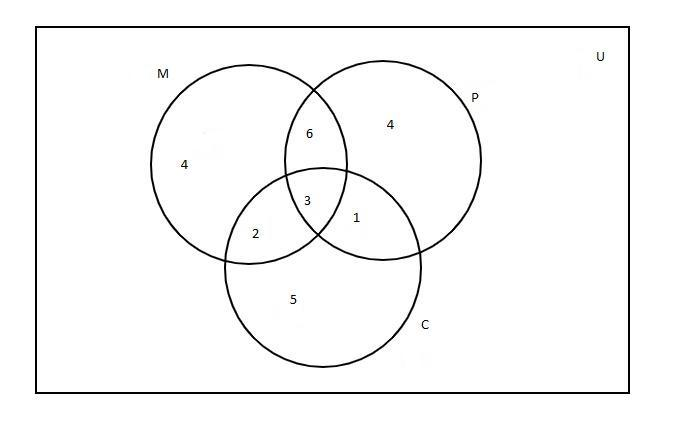
In a survey of 25 students, it was found that 15 had taken mathematics, 12 had taken physics and 11 had taken chemistry, 5 had taken mathematics and chemistry, 9 had taken mathematics and physics, 4 had taken physics and chemistry and 3 had taken all the three subjects.
Find the number of students that have taken none of the subjects.
A. 0
B. 2
C. 3
D. 5
Answer
509.8k+ views
Hint: In this question, first draw the Venn diagram with the given data it will give us a clear picture of what we have to find out. The number of students who had taken none of the subjects can be found by subtracting the number of students taken at least one subject from the total number of students in the survey. So, use this concept to reach the solution of the question.
Complete step-by-step answer:
Given,
Total number of students in the survey \[n\left( U \right) = 25\]
The set of students who have taken mathematics \[n\left( M \right) = 15\]
The set of students who have taken Physics \[n\left( P \right) = 12\]
The set of students who have taken chemistry \[n\left( C \right) = 11\]
The set of students taken mathematics and chemistry \[n\left( {M \cap C} \right) = 5\]
The set of students taken physics and chemistry \[n\left( {P \cap C} \right) = 4\]
The set of students taken mathematics and physics \[n\left( {M \cap P} \right) = 9\]
The set of students taken all the 3 subjects \[n\left( {M \cap P \cap C} \right) = 3\]
Here number of students taking at least one subject \[ = n\left( {M \cup P \cup C} \right)\]
From the Venn diagram, we have

\[
\Rightarrow n\left( {M \cup P \cup C} \right) = n\left( M \right) + n\left( P \right) + n\left( C \right) - n\left( {M \cap P} \right) - n\left( {P \cap C} \right) - n\left( {M \cap C} \right) + n\left( {M \cap P \cap C} \right) \\
\Rightarrow n\left( {M \cup P \cup C} \right) = 15 + 12 + 11 - 9 - 4 - 5 + 3 \\
\Rightarrow n\left( {M \cup P \cup C} \right) = 41 - 18 \\
\therefore n\left( {M \cup P \cup C} \right) = 23 \\
\]
So, the number of students taking none of the subjects \[ = n\left( U \right) - n\left( {M \cup P \cup C} \right) = 25 - 23 = 2\]
Thus, the correct option is B i.e, 2
Note: The intersection of two sets \[A\] and \[B\], denoted by \[A \cap B\], is the set containing all elements of \[A\] that also belong to \[B\] (or equivalently, all elements of \[B\] that also belong to \[A\]). The union of two sets \[A\] and \[B\], denoted by \[A \cup B\] is the set of all elements that are found in \[A\] OR \[B\] (or both)
Complete step-by-step answer:
Given,
Total number of students in the survey \[n\left( U \right) = 25\]
The set of students who have taken mathematics \[n\left( M \right) = 15\]
The set of students who have taken Physics \[n\left( P \right) = 12\]
The set of students who have taken chemistry \[n\left( C \right) = 11\]
The set of students taken mathematics and chemistry \[n\left( {M \cap C} \right) = 5\]
The set of students taken physics and chemistry \[n\left( {P \cap C} \right) = 4\]
The set of students taken mathematics and physics \[n\left( {M \cap P} \right) = 9\]
The set of students taken all the 3 subjects \[n\left( {M \cap P \cap C} \right) = 3\]
Here number of students taking at least one subject \[ = n\left( {M \cup P \cup C} \right)\]
From the Venn diagram, we have

\[
\Rightarrow n\left( {M \cup P \cup C} \right) = n\left( M \right) + n\left( P \right) + n\left( C \right) - n\left( {M \cap P} \right) - n\left( {P \cap C} \right) - n\left( {M \cap C} \right) + n\left( {M \cap P \cap C} \right) \\
\Rightarrow n\left( {M \cup P \cup C} \right) = 15 + 12 + 11 - 9 - 4 - 5 + 3 \\
\Rightarrow n\left( {M \cup P \cup C} \right) = 41 - 18 \\
\therefore n\left( {M \cup P \cup C} \right) = 23 \\
\]
So, the number of students taking none of the subjects \[ = n\left( U \right) - n\left( {M \cup P \cup C} \right) = 25 - 23 = 2\]
Thus, the correct option is B i.e, 2
Note: The intersection of two sets \[A\] and \[B\], denoted by \[A \cap B\], is the set containing all elements of \[A\] that also belong to \[B\] (or equivalently, all elements of \[B\] that also belong to \[A\]). The union of two sets \[A\] and \[B\], denoted by \[A \cup B\] is the set of all elements that are found in \[A\] OR \[B\] (or both)
Recently Updated Pages
Why are manures considered better than fertilizers class 11 biology CBSE

Find the coordinates of the midpoint of the line segment class 11 maths CBSE

Distinguish between static friction limiting friction class 11 physics CBSE

The Chairman of the constituent Assembly was A Jawaharlal class 11 social science CBSE

The first National Commission on Labour NCL submitted class 11 social science CBSE

Number of all subshell of n + l 7 is A 4 B 5 C 6 D class 11 chemistry CBSE

Trending doubts
Differentiate between an exothermic and an endothermic class 11 chemistry CBSE

10 examples of friction in our daily life

One Metric ton is equal to kg A 10000 B 1000 C 100 class 11 physics CBSE

Difference Between Prokaryotic Cells and Eukaryotic Cells

1 Quintal is equal to a 110 kg b 10 kg c 100kg d 1000 class 11 physics CBSE

State the laws of reflection of light




